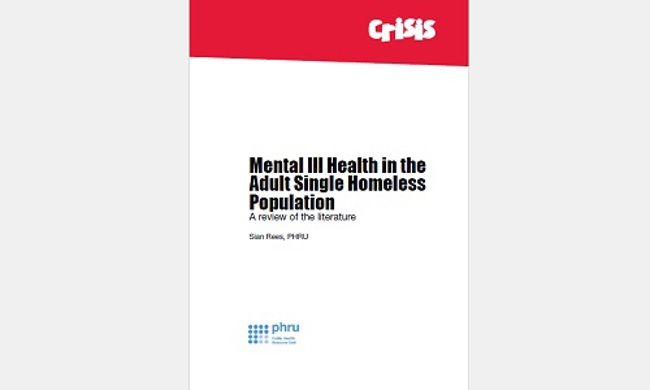Mental Ill Health in the Adult Single Homeless Population (2009)
16.03.2009
It is commonly accepted that mental health problems are much more common among homeless and vulnerably housed people than in the general population. In many instances mental health problems played a significant part in the circumstances which caused those persons to lose their accommodation. The mental health problem may then be exacerbated by the stresses associated with being homeless, which in turn will make it even harder for that person to achieve stability in their housing.
The majority of research into homelessness and mental health considers large urban populations and studies concentrate on the street and shelter populations. Less is known about the mental health of those who live in temporary accommodation or who are part of “the hidden homeless” in unsatisfactory or unstable accommodation or who are outside the main cities of London, Birmingham, Edinburgh and Belfast.
The extent of mental ill health in people who are homeless
- The most quoted and most authoritative source on the extent of mental ill health in the adult population in the UK suggests that the prevalence of common mental health problems is over twice as high and of psychosis 4-15 times as high amongst the homeless population compared to the general population.
- This is worse among street homeless people, who may be 50-100 times more likely to have a psychotic disorder than the general population.
- Serious mental illness is often accompanied by alcohol and/or substance misuse problems. Most studies suggest that around 10-20% of the homeless population would fulfil the criteria for dual diagnosis.
- Homeless people, in particular those with mental ill health, have higher mortality rates than the general population. They are up to nearly 5 times more likely to die than the equivalent age group of the general population.
- Rates of reported personality disorder are also high. In a recent survey of homeless services in England, staff estimated two thirds of their clients presented with characteristics consistent with personality disorder, many of whom were thought to be undiagnosed.
- Among people who are in touch with psychiatric services there is a significant minority that is homeless. A recent European study found that just under a third of the British sample of patients with schizophrenia had experienced homelessness in their lifetime, with over a tenth having experienced “rooflessness.”
- Overall research shows that as the stability of housing increases then rates of serious mental illness decreases.
- Women experience some risk factors (such as physical and sexual violence as a child) for both mental illness and homelessness to a greater extent than men. The rates of mental health problems – including deliberate self-harm (DSH) and suicidal ideation also seem to be higher in homeless women than in men.
- The proportion of homeless people who are mentally ill from BME groups is disproportionate in relation to their proportion in the general population.
- Refugees and asylum seekers also have high rates of mental disorder and are at risk of being in unstable housing.
Support and services
- Research suggests that homeless people may place a low value on health generally in the face of poverty and their day-to-day difficulties. They often do not access health services; few are registered with GPs; and many use emergency services for both physical and mental health care.
- In terms of service provision for this group there can be an inevitable tension between the views of housing providers who want tenants that are perceived not to be a “problem” and mental health providers who want stable housing outcomes for their service users.
- There is an ongoing debate about the models of interventions that will most help this population. Tentative conclusions suggest assertive models of
psychiatric care closely linked with housing provision can achieve both good mental health and housing outcomes. There is also some support from US
research for approaches that do not insist on initial engagement in treatment programmes in order to access housing.
Gaps in knowledge include:
- The mental health of subgroups of the street/hostel populations, such as women and black and ethnic minority groups.
- The mental health of the hidden homeless and of rural populations.
- A greater understanding of what triggers or contributes to homelessness among those with existing mental ill health and personality disorders, alongside a better understanding of outcomes for this population.
- Effectiveness and acceptability of different approaches to intervention.
Reference
Rees, S. (2009) Mental Ill Health in the Adult Single Homeless Population: A review of the literature. London: Crisis.

